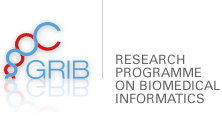
12/04/2016
Thousands of genes from the umbilical cord change their activity in response to amniotic sac infection in preterm birth
A study published in the latest issue of Pediatric Research, the official journal of the American Pediatric Society (APS) and the European Society for Pediatric Research (ESPR), describes the largest molecular signature to date of the fetal inflammatory response, found in umbilical cord tissue from extremely preterm newborns. The research was conducted by Daniel Costa, paediatrician at the Hospital de Figueres (Figueres), and Robert Castelo, leader of the Functional Genomics group of the Research Programme in Biomedical Informatics (GRIB), joint research programme of the Hospital del Mar Medical Research Institute (IMIM) and the Department of Experimental and Health Sciences (DCEXS) at Pompeu Fabra University (UPF).
According to the World Health Organization, one in every ten babies is born preterm, that is, born before 37 weeks of pregnancy are completed, and those born earlier than 28 weeks of gestation (around 5% of all preterm births) are considered extremely preterm. Thanks to the advances in perinatal medicine, extremely preterm babies increasingly survive premature birth. However, they often develop diseases of prematurity, such as perinatal brain damage ranging from mental retardation to cerebral palsy. More concretely, before birth about 30% of these newborns suffer an intra-amniotic infection that triggers an inflammatory response in the fetus, also known as the fetal inflammatory response (FIR), increasing their risk of disease and mortality. Although this association is well characterized, little is known about the extent of molecular changes that participate in FIR and their implication in diseases of prematurity.
To conduct the study, Costa and Castelo compared the activity of the umbilical cord genes of 18 preterm infants affected by FIR with extremely preterm infants without FIR. These molecular profiles and their corresponding clinical records were obtained from the cohort of extremely low gestational age newborns (ELGAN), a birth cohort recruited at 14 different hospitals in the USA. The researchers found 3,896 such genes, 1,097 of which showed a minimum 50% change in FIR-affected preterm newborns with respect to non-affected ones. Genes that increased their RNA molecular concentration are mainly involved in the activation of the innate and adaptive immune systems and constitute a valuable source of potential candidate FIR biomarkers . Genes that decreased their concentration, on the other hand, are mainly involved in fetal development, particularly brain development, and provide clues on possible molecular mechanisms leading to brain damage in FIR-affected preterm newborns. All these genes and their documented changes constitute the largest catalogue to date of changes in gene activity associated with FIR.
This research was possible thanks to the families and investigators who generated the ELGAN data, funded by the National Institutes of Health (NIH) in the USA, and thanks to a grant of the Spanish Ministry of Economy and Competitiveness awarded to Robert Castelo.
Reference work: D. Costa and R. Castelo. Umbilical cord gene expression reveals the molecular architecture of the fetal inflammatory response in extremely preterm newborns. Pediatric Research, 79: 473-481, 2016. DOI: 10.1038/pr.2015.233



